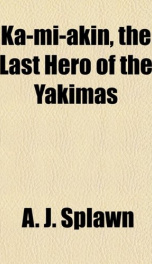ka mi akin the last hero of the yakimas

Purchase of this book includes free trial access to www.million-books.com where you can read more than a million books for free. This is an OCR edition with typos. Excerpt from book: These bold men were pleased with the plan and eager for action. An understanding was soon reached. Quil-ten-e-nock and Sulk- talth-scos-um were to go north; Qual-chan to Puget Sound to meet Leschi and others who would look after that region; while Ka-mi- akin and Ow-hi would go east. Well equipped with tough and wiry horses, and a few men along to look after them, they were soon on their respective ways, full of hope. To the head men of each tribe they dwelt on the menace in the words of Gov. Stevens and insisted that their only hope was to stand together. If soldiers were sent into any part of the Indian country and a battle fought, it should be the signal for a general uprising from every quarter. The council which met in the Grande Ronde valley in 1854 was the most noted gathering of red men that had ever been seen in this vast territory. It lasted five days, during which speakers were heard from nearly every tribe. Only Hal-halt-los-sot (Lawyer) of the Nez Perces, Stic-cas of the Cay-uses and Garry of the Spo- kanes were in favor of making a treaty with Gov. Stevens and selling their lands. The Sho-sho-nees, as well as other tribes not directly interested in the treaty, said: "We have been for many years in almost constant warfare with the whites and are in a position to begin hostilities at any time. If you decide on war and begin to fight, let the signals flash from the mountain tops and we will do our part; but we will fight only in our own country." The Flat- heads were not represented in this council, though many of them fought in the war later on. Lawyer and Stic-cas hung out strong for a council with Stevens, taking the view that if all were in a position to hear directly what the emissary of the whites had to say, war might, perhaps, be avoided; but they were muc...
Info about the book
Author:
Series:
Unknown
ISBN:
1112217193
Rating:
4.5/5 (3)Your rating:
0/5
Languge:
English
Users who have this book
Users who want this book
What readers are saying
What do you think? Write your own comment on this book!
write a commentif you like ka mi akin the last hero of the yakimas try:
Other books by this author
Do you want to exchange books? It’s EASY!
Get registered and find other users who want to give their favourite books to good hands!

